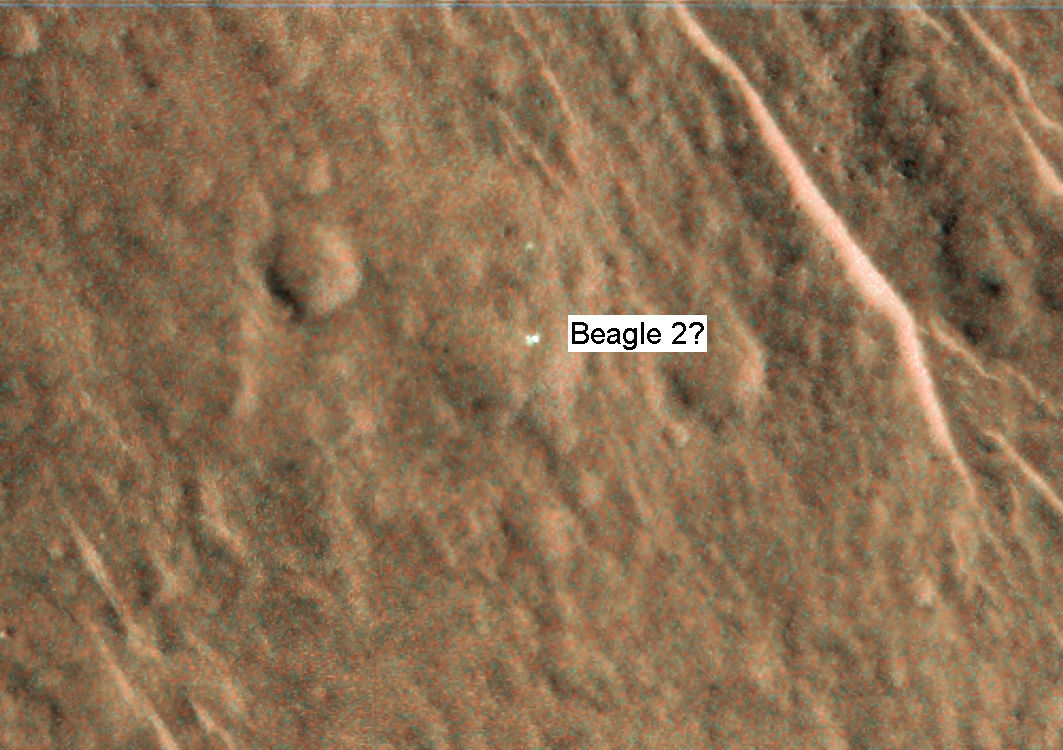So you’ve made a scientific discovery – what next? Communicating your finding to the public without succumbing to the many pitfalls along the way is a tricky business, as Simon Perks reports

Mark Sims gets a lot of e-mail. As professor of astrobiology and space instrumentation at the University of Leicester in the UK – and previously the mission manager of the Beagle 2 Mars lander project – each day brings a deluge of correspondence. But the message that popped up in his inbox on 23 November last year caught his attention. It was from a former member of the European Space Agency’s Mars Express operations team who had detected a “glint” in a large impact basin close to the Martian equator after analysing images taken by the HiRISE camera on NASA’s Mars Reconnaissance Orbiter. And not just any impact basin. This was Isidis Planitia, the intended landing site of the Beagle 2 spacecraft, which was lost on Christmas Day in 2003.
This was not the first time that someone had claimed to have located the lost lander. But it was one of the most promising. So scientists from the HiRISE team, the Beagle 2 project team and NASA’s Jet Propulsion Laboratory obtained further images and analysed them in detail. They scrutinized the shape, size, height, colour and relative position of objects in the photographs. And they checked and rechecked their findings until they were all in agreement. On 16 January the UK Space Agency announced that, after over a decade lying in solitude on the surface of the red planet, Beagle 2 had been found.
The dangers of discovery
So far, the claim of Beagle 2’s discovery remains unchallenged and people seem to agree that the finding does indeed seem sound. But announcing major scientific findings doesn’t always go so smoothly. It can be a risky endeavour – all the more so when it is likely to attract significant public interest, or has implications for government policy. It is no longer a case of simply submitting a paper and leaving it at that. There can be messages to hone, press conferences to organize and journalists to respond to. And it is important that scientists have the ability – and the support – to deal with this because it is all too easy to get it wrong.
When astronomers working on the Background Imaging of Cosmic Extragalactic Polarization (BICEP2) telescope at the South Pole claimed in March 2014 to have found the first evidence for primordial “B-mode” polarization of the cosmic microwave background, it was heralded as groundbreaking proof of the existence of gravitational waves and of cosmic inflation in the early universe. But other researchers soon began to raise doubts about the results. And it has now been shown that the BICEP2 analysis, announced at a press conference prior to peer review, was deeply flawed (see “BICEP2 withdraws cosmic claims”, March pp6–7). The much trumpeted “proof” of inflation was, in fact, a foreground effect caused by dust within the Milky Way.

Another example of a discovery getting extrapolated too far too soon occurred in 2011 after the OPERA collaboration announced at a meeting at CERN and on a pre-print server that it had observed neutrinos travelling from the Geneva lab to its own facility in Gran Sasso, Italy, at faster than the speed of light. Despite the team’s initial cautious announcement and a sceptical response from fellow physicists, the story was soon picked up by the media and amplified around the world as a revolution in our understanding of one of the most fundamental rules of physics. So it came as a shattering blow when it turned out that the so-called revelation was no more than a case of faulty wiring within the experiment itself.
Communicating science
What causes scientists to get themselves into such situations? One of the biggest issues, it seems, is the pressure to announce things sooner rather than later. As Sims says, whoever gets there first gets the credit. This is a noble aim but it can lead to results being announced before they have been scrutinized fully, or to discoveries being over-hyped. “There’s always some pressure to make a splash with your work,” says Mark Birkinshaw, professor of cosmology and astrophysics at the University of Bristol, UK, “whether that’s for a promotion or to secure funding.” And people with healthy egos, suggests Ethan Vishniac, professor of astronomy at the University of Saskatchewan in Canada and editor-in-chief of The Astrophysical Journal, may not have a good sense of the limits of their work.
Another factor is the difficulty faced by scientists in communicating complex ideas in a clear and meaningful way. “Typically they err by simplifying their results to the point where their description is technically incorrect,” says Vishniac. It can also be challenging, admits Pierre Meystre, professor of optical sciences and physics at the University of Arizona, US, and lead editor of Physical Review Letters, to explain the context of important findings – and the uncertainty within them – to a non-scientific audience. And this can easily lead to misinterpretation of their results. “It can be difficult to communicate nuance,” he explains. “We have a hard time simplifying things without making them wrong.”
Different language used by scientists and non-scientists can also present a significant barrier to communication. Creationists jump routinely on the fact that evolution is “only a theory”, despite the fact that, for scientists, the word “theory” has a very specific meaning and implies much more certainty than the term does for a lay person. And in 2009 scientists at the Climatic Research Unit of the University of East Anglia, UK, came under fire when it was revealed that a researcher had referred in hacked e-mails to the use of a particular “trick” in the analysis of tree ring data. This was touted widely by climate sceptics as devious and fraudulent manipulation of data, when in fact it was shown later to refer to a perfectly legitimate way of handling complex datasets.
How to publicize your research effectively

Mark Birkinshaw: Professor of cosmology and astrophysics at the University of Bristol
Get help from someone experienced, talk to someone in the science-communications business and use the university public-communications office. If you’re really keen, take one of the science-communications courses.
Pierre Meystre: Professor of optical sciences and physics at the University of Arizona and lead editor of Physical Review Letters
Know your audience and understand why they will be interested. Have a simple message – just one or two things that you want to communicate. Avoid scientific jargon. And never oversell. Some people oversell, and in the end it hurts everybody.
Ed Sykes: Chair of Stempra, a network for science-communications professionals
Think about how to engage with the wider public. If you are working on a potentially controversial project or something of media interest, consider early on the messages you would like to communicate. And when the news breaks, make sure you are available to speak with journalists. This is your opportunity to make sure your work is reported accurately.
Ethan Vishniac: Professor of astronomy at the University of Saskatchewan and editor-in-chief of The Astrophysical Journal
A small solid claim is better than a large uncertain one. It’s very difficult to convey essential context and background to new scientific results. Don’t be afraid to give a bit of context and history.
But it is not just scientists who are to blame, says Sims. Media reports can also paint an overly simplistic picture of scientific discoveries. “The media want certainty,” he says. “They want things to be black and white. But science isn’t black and white.” And the desire to sell the story can sometimes trump the reality of what is being reported. The media want stories that will sell, says Birkinshaw, and concentrate on the aspects that make good copy. “When I’ve been sent a draft article on some result for comment,” he says, “I usually find that though it’s been written to be engaging, the ‘hot button’ words don’t accurately reflect what the research said and the caveats to the work are often lost.”
Ed Sykes, chair of Stempra, a UK-based network for science communications professionals, emphasizes that the blame shouldn’t be put on one individual or group – there is plenty of opportunity for things to go awry. “There is pressure on scientists to look at sexy topics and to publish interesting results,” he says. “Journals are under pressure to pick topics that will get the most attention. Funders want to get their messages out and to attract the attention of journalists. Journalists work under time pressure and want interesting stories. And articles go to sub-editors, who will find pictures, choose headlines and edit the text.” So what can scientists do to improve the way in which their findings are communicated? Sykes, and others quoted here, give their advice in the box above.
Uncertainty and peer review
Given the potential for even the most incontrovertible of discoveries to be reported incorrectly, how certain of their results should scientists be before they tell the world? “As scientists, we’re never certain,” Meystre argues. “That’s what science is about. That’s how progress is made.”
Vishniac, meanwhile, emphasizes the role that peer review can play in weeding out erroneous results. “Scientists should have convinced their peers before they try to convince the public,” he says. “It’s all too easy to convince yourself. Peer review is an essential part of this process.” So is it acceptable for scientists to announce results of discoveries before they have been subject to peer review? “No,” Vishniac insists.
Meystre echoes this sentiment. “Peer review is the only reliable mechanism,” he says. “It maintains the credibility of the scientific process.” Meystre does, however, acknowledge that the mechanism is far from ideal. “I’m not going to claim that the peer-review process is perfect, because it’s not,” he says. “But I’m not aware of a system that’s better.”
Peer review can be a slow process. Furthermore, not every discovery will find a journal interested in publishing it. And the rise of pre-print servers, such as arXiv, puts unreviewed findings directly into the public domain. So is peer review always a realistic prerequisite to communicating scientific results to the wider world?

Birkinshaw proposes a pragmatic approach. Most results require some peer review before publicizing, he says, but there are circumstances where this isn’t realistic. For example, when a result is attracting a lot of attention, it can be hard to avoid announcing it immediately. Sykes emphasizes that the potential impact of the work should also be taken into consideration. “If it’s just an interesting thing,” he says, “it’s OK to announce without peer review. But if it is arguing for a particular policy or has a significant impact on other people, it needs to be peer reviewed.”
The cost of getting it wrong
Poorly communicated science does not go unnoticed. And its impact can be significant. “I think it puts the public off,” says Birkinshaw, “and may hurt the recruitment of young scientists. And the level of hype is not appreciated – there seem to be too many breakthroughs!” Meystre adds that with a low level of public scientific literacy, especially in the US, misinterpretation of science can lead to mistrust in scientists and the rise of pseudoscience in areas such as climate change and childhood vaccinations. Another ugly side of science communication when it turns sour is that it can affect individuals and hurt long-standing collaborations. In the case of OPERA and the neutrinos, for example, the head of the OPERA programme subsequently resigned from his post, and CERN was quick to distance itself once the result was found to be flawed.
A more positive picture
According to the Ipsos MORI Public Attitudes to Science survey in 2014, which quizzed the UK public, some 90% of respondents trust scientists working in universities to follow the rules and regulations relating to their profession, up from 84% in 2011. However, half said that scientists put too little effort into informing the public about their work and over two-thirds would like scientists to spend more time discussing the social and ethical implications of their work with the general public.
The capacity for science to enthuse and excite us remains, nevertheless, undimmed. Just as families huddled around their television sets to watch Neil Armstrong take his first tentative steps on the moon in 1969, we seem to have a special place in our hearts for his modern-day counterparts, such as UK physicist Stephen Hawking and Tweeting Canadian astronaut Chris Hadfield. And we never cease to be captivated, it appears, by scientists’ quest to expand the frontiers of knowledge – even if they sometimes stumble along the way.
So what of Beagle 2? After the fanfare of the initial announcement, are we set to be disappointed in a few months’ time by a flood of counter-claims or a quiet retraction? Sims is sanguine. “I’m 96–99% certain that it is Beagle 2,” he told Physics World, “but nature can play tricks on you.” So further photos will be taken, more analysis will be done and, in time, a paper will be prepared so that the team’s results can be examined in detail by the wider scientific community. “It’s either Beagle 2,” he adds, “or the most peculiar bit of Martian geology I’ve ever seen.”



